Dairy contracts in European countries: research
Analysis on the current state of the dairy sector and supply chains within European countries and the application and impact of mandatory written contracts and their suitability and potential application in Scotland.
2. Overview of the current dairy landscape in Scotland
Key points
- Prices paid to farmers follow trends based on commodity markets due to the fact the same milk can be used to produce different manufacturing products.
- Based on 2017 figures almost 80% of the milk collected in Scotland is used for drinking milk and cheese (most of which is Cheddar). Both markets are very competitive at the retail level, which is the main market destination.
- The retail market is highly competitive, with private labels being an important category. Processors supply retailers both their branded products and private labels. This may reflect both presence of install capacity (when producing only branded products) and decline of major brands.
- Contracts are usually open ended (evergreen) with processors generally committing to purchase all the milk produced on a farm (i.e., exclusivity).
- Notice periods are generally long, from a minimum of three months to up to 12 months required from the farmer to the processor, with sometimes longer notice periods required from the processor to the farmer.
- Farmers’ participation on the negotiation of contracts depends on the type of organisation i.e., whether it is a cooperative, a private company negotiating with a producer organisation, formal representative framework set up for the purpose or through dialogue at ad-hoc meetings. Similarly happens with the resolution of conflicts.
- Because of the competitive environment faced by processors, price clauses in contracts between processors and suppliers have historically been built around flexibility, i.e., the use of what is termed ‘purchaser discretion’, which means that a processor (milk purchaser) has the right to vary the farm gate price as and when they see fit.
- Prices paid to farmers tend to consider the following elements: valuation of the milk by constituent content (e.g., butterfat, protein), quality requirements, pricing adjustments for milk quality, volume collection, transport, farm management practices.
2.1 Structure of the industry
2.1 The purpose of this section is to describe the business environment of the dairy sector in Scotland as well as the features of the contracts that are used. Due to lack of availability the trade figures refer to the UK instead of Scotland.
Production
2.2 The UK accounted for 9.7% of EU milk deliveries in 2017, i.e., 15.1 billion litres, of which approximately 10% were in Scotland. UK exports of dairy products, converted into milk equivalent (ME) was 22.6% of the milk deliveries and 4.4% of EU dairy exports in ME (CLAL, 2019). A summary of statistics for the dairy sector in the UK is presented in Table A.1 in the Annex.
2.3 The latest information of the dairy sector in Scotland (2018) indicates that there 918 dairy herds (39 herds less than in 2017). They represents approximately 9% of the total UK herd and are mainly concentrated in the South West of the country. The number of dairy cows in Scotland has increased to just under 179 thousand cows (the highest since 1997). Figure 1 shows compares Scotland and Rest of UK milk production and both follow a similar trend.
Figure 1: Scotland and Rest of UK production of milk 2003-17
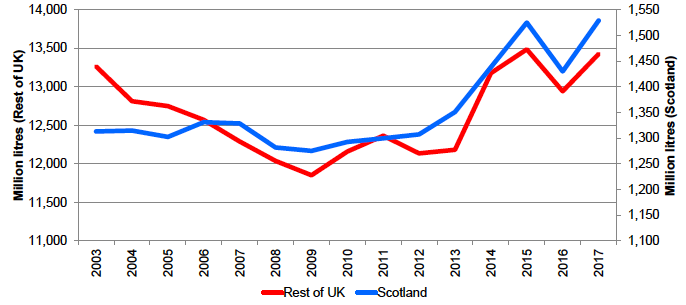
Source: Defra and Scottish Government.
2.4 One of the important issue on milk collection is the seasonality of the deliveries (i.e., the increase of milk deliveries in spring and the decrease in autumm). Figures 2 and 3 present a delivery index by major processors for 2017 and 2018. Whilst some of the companies show the expected swing on deliveries others show very stable milk collection, which could be the reflection that part of the milk collected comes from the spot market as needed.
Figure 2: Scotland - Total deliveries index by selected processor - 2017
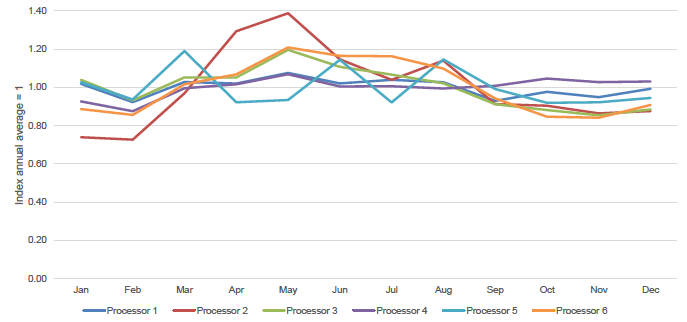
Source: Scottish Government, Milk utilisation survey.
Notes: From farms in Scotland and elsewhere.
Figure 3: Scotland - Total deliveries index by selected processor - 2018
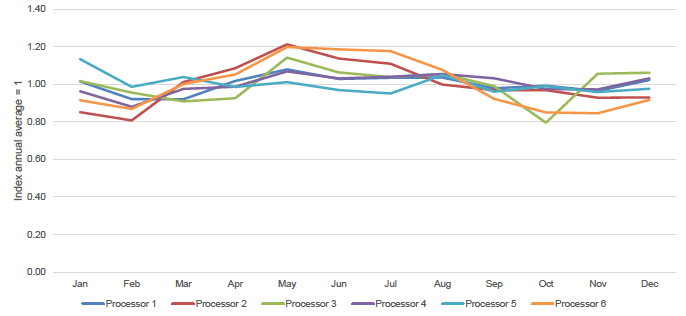
Source: Scottish Government, Milk utilisation survey.
Notes: From farms in Scotland and elsewhere.
2.5 Figure 4 shows the UK prices paid for milk from 2004 to 2018 for different type of contracts. After a break of their historical trend during the late 2014 to 2016, prices have converged again to similar values despite their different uses. In addition, the figures shows that there are little differentiation on the prices paid for milk for different uses (i.e., same milk can be used for all the different products).
Figure 4: UK - Prices paid for milk 2004-18
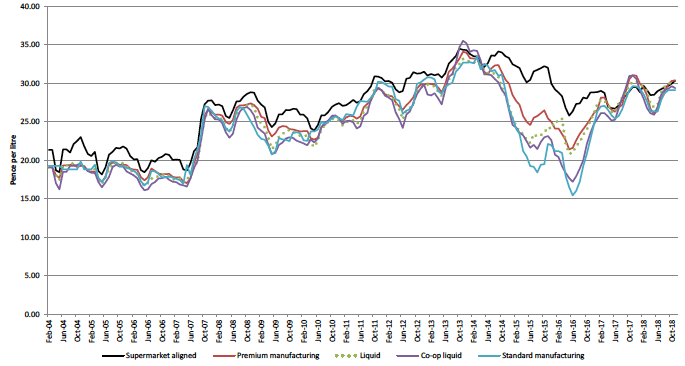
Source: Based on AHDB data
Processing
2.6 Although the number of dairy companies operating in Scotland is relatively large (97 according to the Milk and Dairy Products approved premises, 2018), as shown in Figure 5, the top five companies represented about 94% of the milk collection in 2017 with the top milk collector being 32% of the total milk.
Figure 5: Scotland – Milk collection share by company - 2017
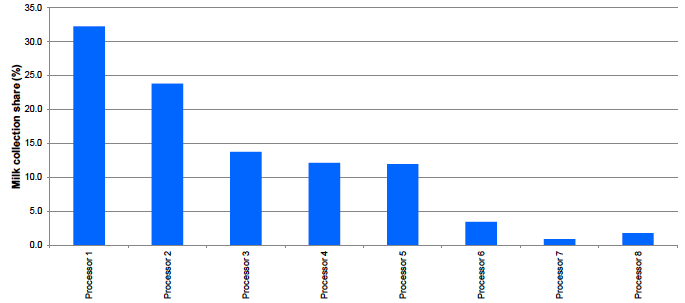
Source: Scottish Government, Milk utilisation survey.
2.7 In terms of milk use (see Figure 6), drinking milk represented about 41% and cheese 38.4%, making between almost 80% of the milk utilisation.
Figure 6: Scotland – Milk collection share by product - 2017
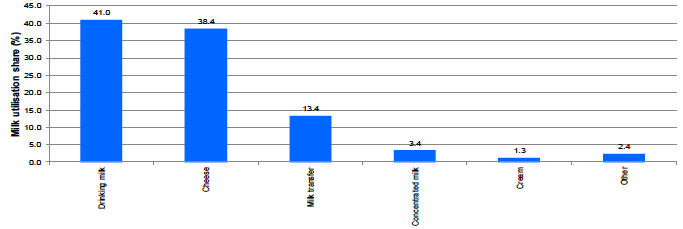
Source: Scottish Government, Milk utilisation survey.
2.8 If one considers only the processing of drinking milk and cheese as shown in Figure 7 each company has different specialisation. Note that at the UK level from the total milk that goes to cheese, 72% is for the production of Cheddar (the information is not available for Scotland; however, it is expected the proportion to be similar).
Figure 7: Scotland – Drinking milk and cheese milk utilisation share - 2017

Source: Scottish Government, Milk utilisation survey.
2.9 Figure 7 also highlights that processors that represent more than 90% of the milk collection in Scotland are very exposed to highly competitive markets, i.e., drinking milk and cheese (i.e., as pointed out by DairyUK, processors operate in an environment of intense competitive pressure and uncertainty over market returns).
Retail market
2.10 As most of the top processors operating in Scotland market their products across the UK, the relevant retail level is the UK level (or Great Britain, as Kantar Worldpanel data do not include Northern Ireland). As it is
not possible to consider all the dairy products, the focus of this section will be drinking milk and cheese, which are the two products that collect most of the milk processed in Scotland. Figure 8 shows the evolution of the estimation of annual sales of drinking milk and cheese between 2013 and 2017. Drinking milk displays a decreasing trend, whilst cheese trend is stable.
Figure 8: Great Britain – Drinking milk and cheese sales indexes
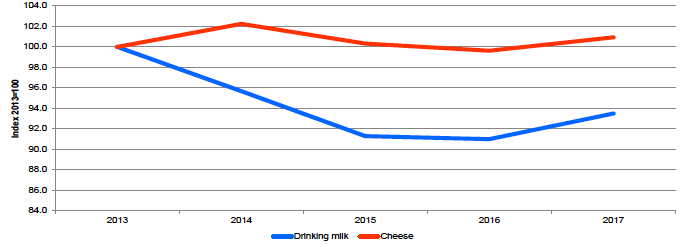
Source: Own elaboration based on Kantar Worldpanel data.
2.11 Table 1 shows the increasing importance of private labels (i.e., supermarkets’ own labels in contrast to branded products) on the drinking milk market (78% in 2017). Within the category, the most important product is non-organic, semi skimmed milk private label (almost 47% in 2017).
Table 1: Great Britain - Market shares – Drinking milk (percentages)
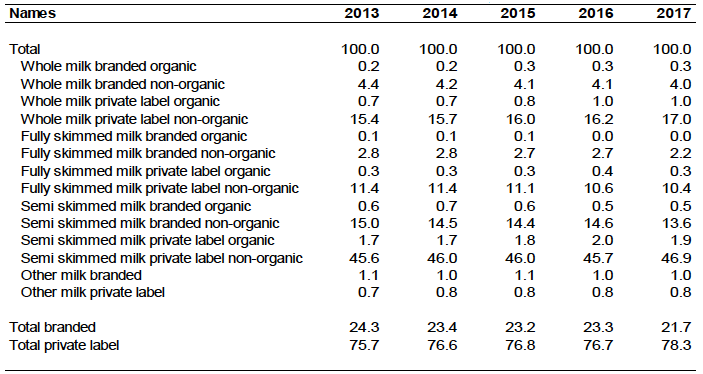
Source: Own elaboration based on Kantar Worldpanel data.
2.12 Table 2 presents the market share of different cheeses. As in the case of milk the proportion of private label cheeses have increased since 2013 reaching 58% in 2017. Whilst Cheddar type private label cheese has maintained its share around 28%, branded Cheddar has shown a decreasing trend being replaced by ‘other cheeses’ (private label).
Table 2: Great Britain - Market shares – Cheese (percentages)
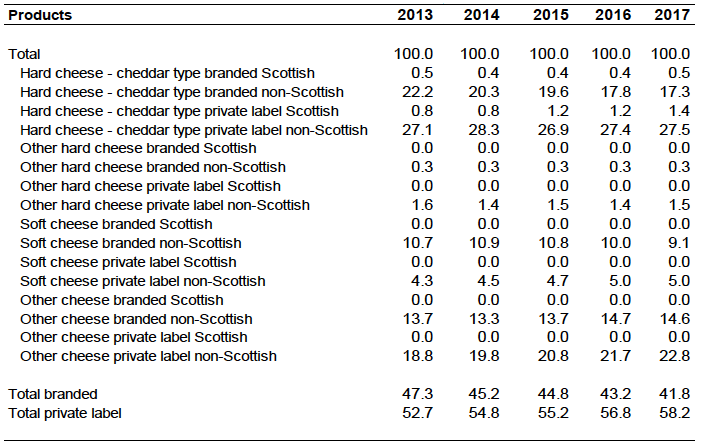
Source: Own elaboration based on Kantar Worldpanel data.
2.13 To appreciate the full picture is important to note that processors not only sell branded products but also private label ones (the proportion of price labels on the total production varies by processor). The economic literature (e.g., Mills, 1995) points out that processors manufacturing private labels in addition to their branded products could be due to either excess of capacity and/or brands with declining sales. Given the trends showed in Figure 8, branded products have declining trends. In addition, given the share of private labels on the drinking milk and cheese markets, it is highly probable that most processors (if not all) would be operating under excess of capacity without producing retailers’ brands.
2.2 Scottish dairy contracts
2.14 Although most of processors operating in Scotland were requested copies of their contracts in order to make a comparison only one of them provided it. Therefore, this section relies heavily on DairyUK’s contribution, which provides an overall description of contracts in the UK.
2.15 Generally contractual arrangements in the dairy industry are based around flexibility in pricing to cater for the volatile market the industry operates in combined with security of supply chain arrangements.
2.16 Security of outlet and input is paramount to the successful operation of the dairy industry supply chain. Farmers need a secure continuous outlet for their milk. Raw milk is produced continuously during the year and it is a perishable product. Farmers do not have the storage capacity to keep more than a few days of production on the farm. The natural variability of milk production also gives uncertainty to the volume being produced.
2.17 Processors need a secure continuous flow of raw milk. Processors likewise do not have the capacity to store a significant volume of raw milk. Processors require a continuous flow of product, to maximise utilisation of processing plant and to service markets, especially fresh product markets. Processors need to obtain raw milk as much as farmers have to sell raw milk.
Offer contract and duration
2.18 Milk processors are usually supplied by a large number of dairy farmers. As a result processors tend to use standardised contracts for all of their supplying farmers or groups of farmers. As pointed out by Dairy UK processors do not negotiate contracts individually with dairy farmers as it is impractical to do so.
2.19 Because of the aforementioned reasons behind the operation of
dairy farms and processors, contracts are usually open ended (evergreen). Notice periods are generally long, from a minimum of three months to up
to 12 months required from the farmer to the processor, with sometimes longer notice periods required from the processor to the farmer. The length of notice periods is designed to:
- Ensure processors can service long term contracts with their customers.
- Give processors time to secure alternative sources of supply if dairy farmers resign.
2.20 As regards farmer participation in determination of contracts, it differs by type of organisation:
2.21 Co-operatives - Around 45% of Scottish milk supply is purchased by dairy co-operatives. Dairy co-operatives are under the ownership and control of dairy farmers and the content of contracts or their equivalent are determined within the governance structure operated by the co-operative.
2.22 For private dairy companies the process by which contracts are developed and amended can be through:
2.23 Negotiation with representative organisations - Farmers supplying Lactalis are members of the Milk Suppliers Association. The MSA is a co-operative. It does not purchase the milk of its members but it engages directly with Lactalis in determining milk prices. MSA is not registered as a Producer Organisation but its status as a co-operative provides it with exemptions in competition law that entitle it to participate in price discussions.
2.24 Consultation through other frameworks - Some processors consult their supplying farmers through either a formal representative framework set up for the purpose or through dialogue at ad-hoc meetings. Farmers supplying Muller are organised in the Muller Milk Group.
2.25 Overall, taking into account co-ops and other representative structures into account, a major portion of Scottish milk supply is operated under arrangements that provide a mechanism to consult the views of dairy farmers in the development of contracts and determination of milk prices.
Milk pricing
2.26 Processors (co-operatives or private companies) operate in an competitive environment, under uncertainty over market returns and do not have the resources to protect their supplying farmers from price fluctuations. As a result of these commercial pressures, price clauses in contracts between dairy processors and their supplying farmers have historically been built around flexibility. Very specifically this had led to the widespread adoption by milk processors of the use of what is termed ‘purchaser discretion’. This is where the processor (milk purchaser) has the right to vary the farm gate price as and when they see fit (Dairy UK).
2.27 Overall, in conjunction with the processors commitment to buy all the milk produced by a farmer, this results in processors taking the volume risk whilst dairy farmers carry the primary burden of price risk. However, processors are not completely exempted from price risk. For instance, manufacturers of mature cheese can be particularly affected by the differences in raw milk costs and price paid for the finished product given the lengthy period of maturation (e.g.,two years).
2.28 Prices paid to farmers tend to consider the following elements:
- Valuation of the milk by constituent content (e.g., butterfat, protein)
- Quality requirements
- Pricing adjustments for milk quality, volume collection, transport etc.
- Farm management practices
Volume collected
2.29 Processors are generally committed to purchase all the milk produced on a farm (i.e., exclusivity).
Dispute resolution
2.30 Dispute resolution also differs by type of organisation:
2.31 Co-operatives – Complaints within a co-operative structure follow the procedures established by the co-operative.
2.32 Negotiation with representative organisations - Contracts establish that in case of conflict a mediated solution will be sought. The disputes are treated by the board committee encouraging an agreed resolution, and then
if an agreement is not reached again an agreement is sought through mediation. The aspiration is that the last decision on the dispute will remain always in the hands of the parties, not with a third party. Farmers that want to leave after a period notice. In addition, if the mediation fails the contract has a deadlock clause in which the farmer can move after a period elsewhere.
2.33 Other frameworks – If the firm is relatively small there may not be any pre-established mechanism and the conflict solution may be left to left to the parties (i.e., processor and farmer) to discuss the problem.
Market transparency – information disclosure
2.34 Whilst milk collection and their utilisation are gathered by the Scottish Government and Defra, dairy contracts are confidential.
Contracts between processors and retailers
2.35 Based on the interviews it was clear that the contracts between processors and retailers are varied in terms of clauses and duration (i.e., they change by retailer and product).
2.36 Diagram 1 presents a summary of the structure of the dairy contracts in Scotland.
Figure 9: Diagram 1- Scottish dairy contracts
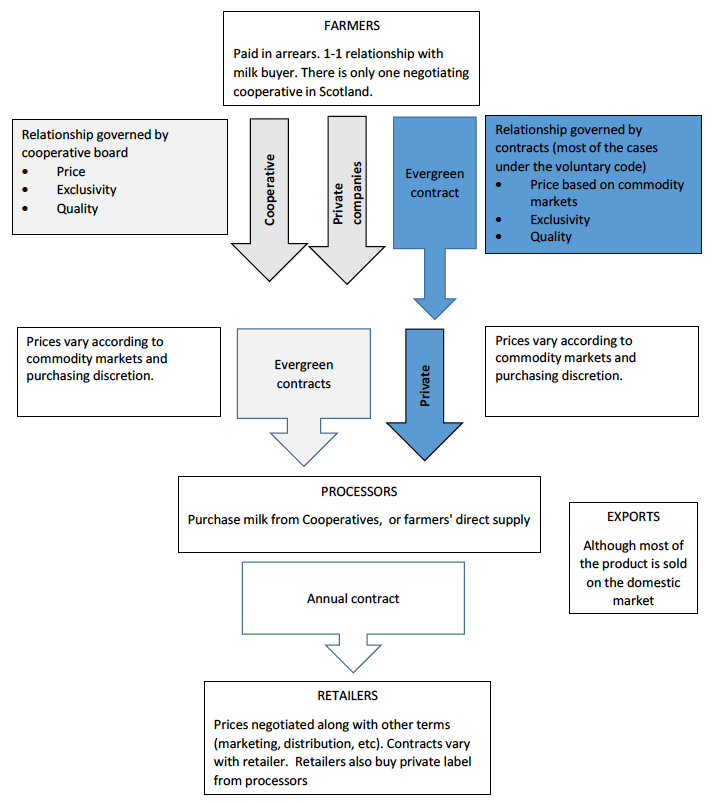
Contact
Email: socialresearch@gov.scot
There is a problem
Thanks for your feedback